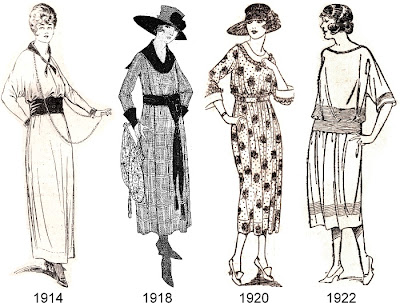
The defining features of the 1900s period were the pigeon-breasted exaggerated S-bend silhouette and umbrella-flared skirts. Restraint was not the key; extravagant hats were in vogue, and bodices were embellished with all manner of trimmings, lace and froufrou. The post-Edwardian period, in contrast, brought a much more slender, columnar silhouette, delicately embellished and topped with an enormous hat.

Obviously the Great War was only 1914-18, but it's a useful designation for the styles between the Edwardian and Flapper eras. Skirts were still long, just starting to rise by the early 20s; bodices were blousy. The waistline gradually became less defined through this time, though it was still on the natural waist in 1920.

Flapper is a general classification since not everyone during the 'twenties was a flapper, but all fashion during this period was certainly influenced by the movement. By 1923 the waistline had made its exit, and the silhouette had become leaner. Uneven "handkerchief" hems (where the hem falls into points), and skirt godets (as seen in the 1929 dress above) were popular. Hemlines were rising higher than ever before, hitting knee-length by 1926. Hair was bobbed and the cloche hat was in its heyday.

Around 1929 the waistline began to re-emerge, but was not accentuated. Through most of the 1930s the silhouette remained long and lean; hemlines hung around mid-calf. This is the era of bias-cut gowns and floaty florals. Popular detailing during this period included puffed, flutter or frilly layered sleeves, and neckline interest in the form of bows and jabots.

My personal favourite. Tailoring was key, and subtle gathers and shirs replaced the ruffles and frills of the early 30s. Sleeves were set-in and slim fitting, and often had puffed shoulders, which developed into square shoulders as the war progressed and man-tailoring became more fashionable. Skirts were flared and swingy in the late 30s and early 40s, but narrowed to a slim A-line by 1946 due to fabric rationing. Hemlines rose over the same period to around knee level.

You don't need a diploma in vintage fashion to know that in 1947 Christian Dior launched his "New Look", the ultra-feminine antidote to wartime austerity, which revolutionised the way women dressed. In defiance of cloth rationing (which was still in effect in Britain until 1951) ladies adopted mid-calf length, full skirts. Slim pencil skirts were also popular. The waist was nipped in for an exaggerated hourglass figure. Reacting against the masculine, square-shouldered styles of the war years, the fashionable silhouette gained slightly sloping shoulders; dolman, Raglan, cap and smoothly set-in sleeve styles dominated.

Although nipped-in waists continued to be popular, the late 50s saw the rise of a looser silhouette, defined in boxy jackets, straight skirts and swing coats. Detailing was toned down and high, round 'jewel' necklines were popular, with short or elbow-length sleeves. Hair was worn mid length, either big and bouffant (Jackie O) or in a beehive updo.

Mod is the shortest of my fashion eras, but no less iconic for it. The miniskirt, A-line shift dresses and bold monochromatic or colourful psychedelic prints defined the fashion world. Almost as soon as it had begun, Mod started to give way to Hippie styles, which in turn morphed into soft, Bohemian and Victorian revival fashions.
Vintage clothing is generally categorised by decade. I do it too; it's the easiest way. But it doesn't really make sense since just about every decade in the 20th century saw major style changes and innovations - a frock from 1941 could hardly be more different from a late 40s New Look number, and an early 60s dress is poles apart from a 1968 mini or tunic-and-flares ensemble. Even the fifties, so closely associated with the hourglass shape, had already started moving away from Dior's 1947 New Look and towards boxier 60s styles by the middle of the decade (Dior launched his dropwaist "H-line" collection in 1954). So, here are the fashion era classifications as I see them.
0 comments :
Post a Comment